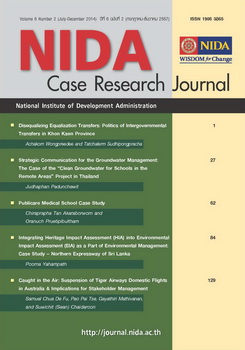Caught in The Air: Suspension of Tiger Airways Domestic Flights in Australia & Implications for Stakeholder Management
Keywords:
Stakeholder Management, Crisis Communication, Public RelationsAbstract
On 2 July 2011, just before the winter holidays in Australia, all flights of Tiger Airways Australia, which is a budget airline founded by Singapore Airlines, were grounded by Australia’s Civil Aviation Safety Authority (CASA) due to a series of safety breaches, which raised questions about safety and its airworthiness. Aviation regulators said that the airline posed “a serious and imminent risk to air safety” and the grounding of an entire airline was the first in Australian aviation history. Due to the short notice of the grounding, coupled with the lack of information from Tiger to itscustomers, many passengers learned about the flight cancellation only when they arrived at the airport. Tiger released a press statement on 5 Jul, 3 days after the grounding. To recover from the situation, Tiger had promised to provide full refunds or ticket credits to customers who have been affected. In view of Tiger’s grounding, their competitors, Jetstar and Virgin, both promised to add extra flights to help stranded passengers, and offered special fares to those affected. Qantas also offered discounted flights, and Qantas engineers called off a scheduled strike at the request of the government to ensure flight disruptions were kept to a minimum. On 10 August 2011, CASA lifted Tiger’s flight suspension; however CASA imposed a comprehensive set of conditions to its operating license. Tiger was unable to resume all flight routes immediately; instead each route could only be reestablished after gaining approval from CASA. This case is a good illustration of stakeholder management in a crisis situation as Tiger Airways had to deal with regulatory bodies, passengers, and competitors at the same time.This case aims to illustrate the topics of stakeholder management, crisis communication, as well as reputation and issues management for business organizations. Through the case of Tiger Airways being grounded, the paper demonstrates how this airlines company managed different stakeholders’ interests. The readers are encouraged to prioritize the issues and stakeholders’ salience (Bundy, Shropshire, & Buchholtz, 2013) to help the organization recover from damaged reputation (De Maria, 2010). Readers of this case will be asked to complete three main tasks. First, the readers will apply stakeholder theory to map various stakeholders and their influence on Tiger Airways on the grounding incident. Second, the readers will evaluate the effectiveness of strategic management of Tiger Airways as described in the case. Finally, the readers will propose alternative strategies for Tiger Airways to handle the situation based on stakeholder analysis. This case is appropriate for upper level undergraduate and graduate students in management, communication, and public relations courses.
Downloads
How to Cite
De Fu, S. C., Tse, P. P., Mathivanan, G., & Chaidaroon, S. (Sean). (2014). Caught in The Air: Suspension of Tiger Airways Domestic Flights in Australia & Implications for Stakeholder Management. NIDA Case Research Journal, 6(2), 129–140. retrieved from https://so04.tci-thaijo.org/index.php/NCRJ/article/view/27685
Issue
Section
Case Study





